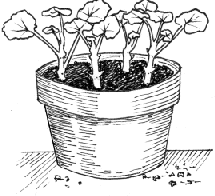We’ll finish our discussion of asexual propagation with a look at some horticultural
methods of propagating plants from plant parts.Cuttings.
Propagation by cuttings involves taking a portion of stem, root, or leaf, and providing it
with the environmental conditions necessary for inducing it to form a new, independent
plant.
Perhaps you’ve rooted stem cuttings in a vase of
water. If all goes well, after several weeks the underwater portion of the stem will begin
to form roots. You may have noticed that some plants form roots much more readily than
others.
Many indoor plants are commercially propagated by
cuttings, as are certain flowering plants such as carnations, chrysanthemums, and
geraniums. Plants usually respond best to a specific form of cutting—for example, one
plant might root more easily from a cutting taken in the spring, while another may
propagate more easily from a cutting taken in the fall.
Some plants that are difficult to root under normal
conditions will root more readily if a rooting compound (actually a plant growth
regulator) is applied.
Rooting geranium cuttings

Layering. Some plants reproduce naturally
by layering. Black raspberries, for
example, form new plants wherever their arching stems, or canes, come into contact with
the soil. Adventitious roots form on the stem while it’s still attached to the parent
plant.
Layering, then, involves the rooting of a
"cutting" before actually cutting it from the mother plant. Not all plants will
readily reproduce by layering, but for those that will, a common method is to bend a
suitable branch to the ground, bury a section, and secure it in place. If the layering is
successful, roots will eventually form on the buried section, and you can separate and
transplant the new daughter plant.
Commercially, layering is used to propagate many fruit
tree rootstocks. The method is also useful in producing large plants quickly. Home
gardeners can multiply some evergreen and deciduous shrubs, currants, and gooseberries by
layering.
Propagating raspberries by layering

